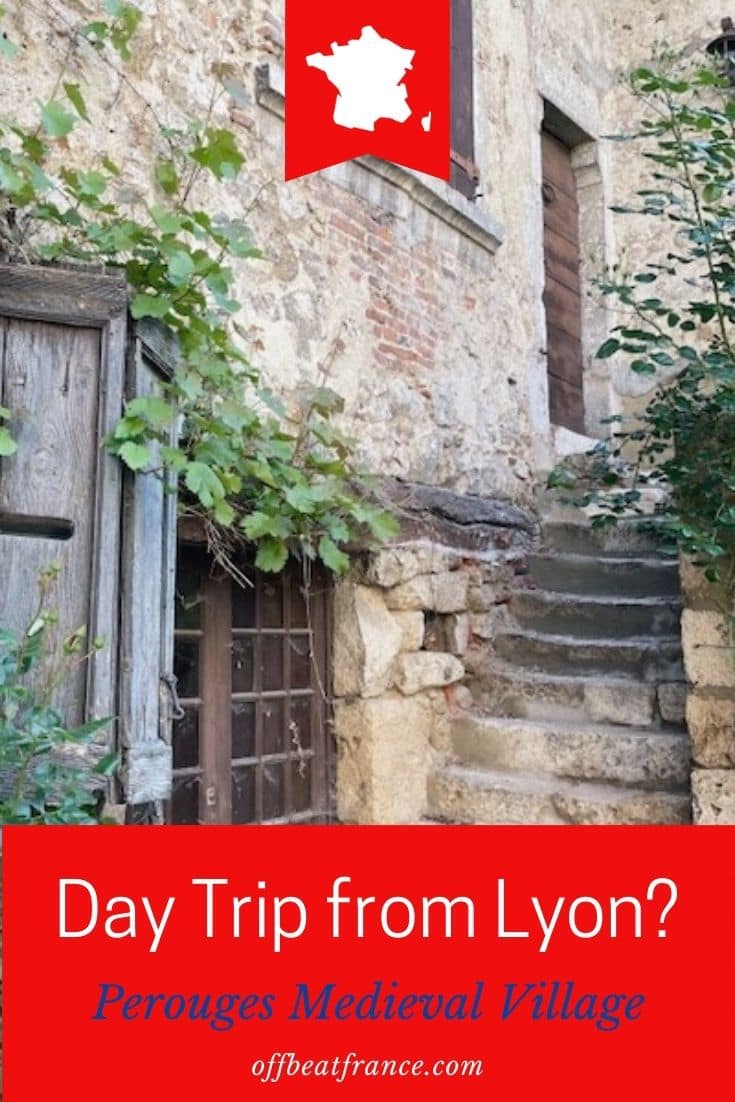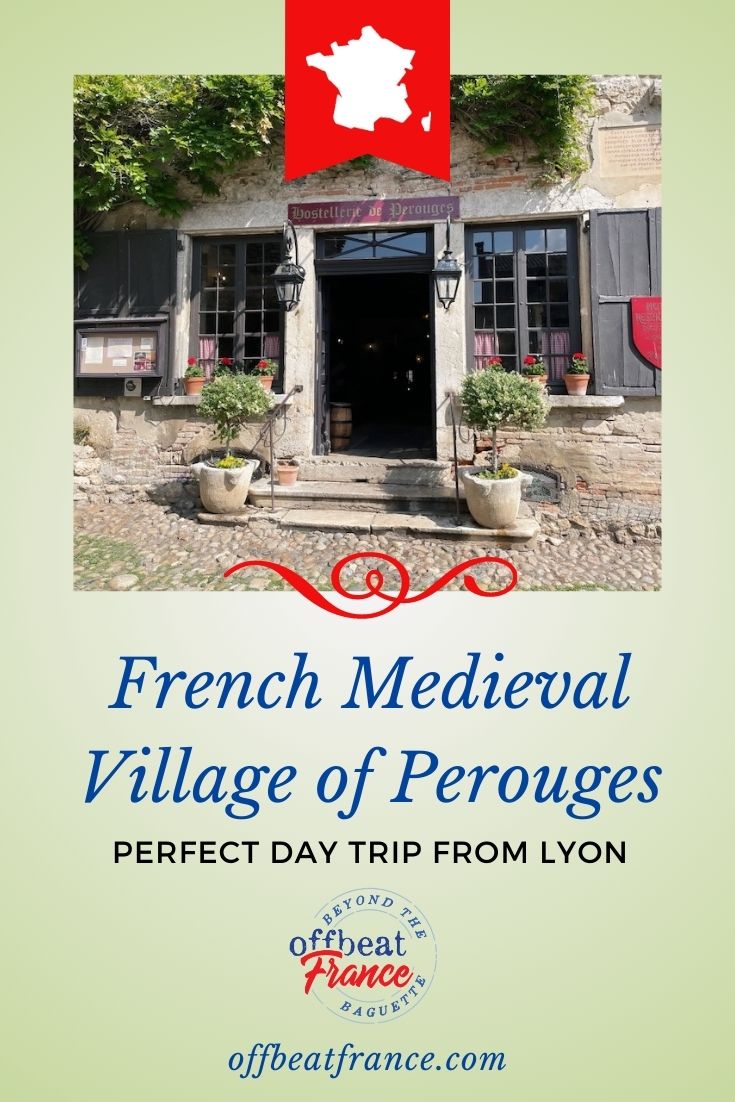Unsure about your French table manners? Click Here to download > > How to avoid these 10 food etiquette mistakes !
- Home ›
- Destinations ›
- Lyon ›
- Pérouges
Perouges, The Medieval Village They Almost Razed
Published 22 May 2023 by Leyla Alyanak
This is the story of Perouges – a stunning medieval village which came close to being destroyed
Walk the streets of the medieval village of Perouges and if it’s early in the morning, before visitors arrive, you might actually think you’ve slipped back a few centuries.
Barely 100 years ago, no one could have predicted the stunning revival story of a village whose end had come.
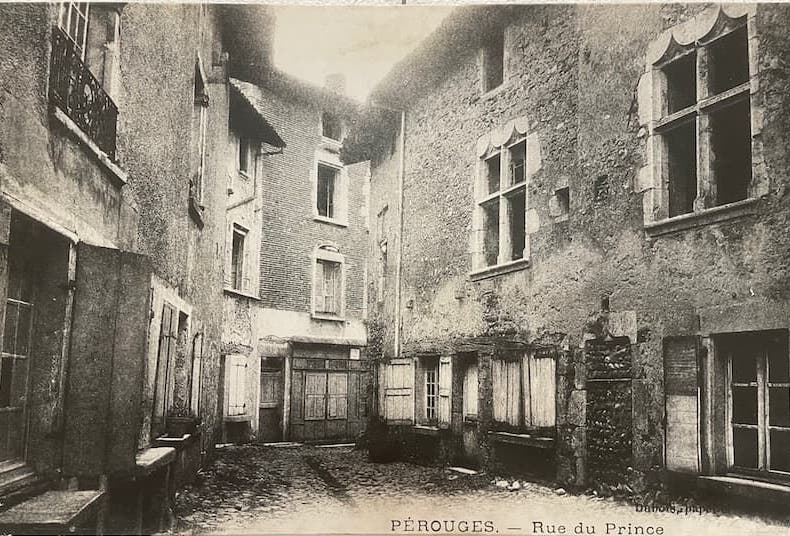
After centuries of commercial growth, the village began to decay (for reasons we’ll read about below).
Houses were sold to builders who dismantled them to use the stone in construction elsewhere, or to recover the occasional stairway or chimney. Businesses had shuttered, and walls crumbled, threatening the occasional pedestrian. Houses were demolished faster than they could be counted and the village was well on its way to being razed.
Horrified at the prospect of destruction, in 1911 a group of concerned citizens – including Edouard Herriot, then mayor of Lyon – decided to save the village and formed an association.
Each member was asked to buy a house in Perouges and to rebuild it.
And so, house by house, the village was reborn. Modern conveniences were added, and curious tourists began dropping by what was fast becoming a medieval village – again.
COMING TO FRANCE? THESE RESOURCES CAN HELP!
🏨 Accommodation - I rent hotels quickly and easily through booking.com
🚘 Car rentals - I use Discovercars, Europe's best car rental website
🚊 Train tickets - I book my train and bus tickets on Trainline
🚌 Day tours - I take the best day tours with Viator and GetYourGuide
Things to do in Perouges, France
- Visit the village’s artisans
- Sample a “galette de Perouges”
- Look closely at the houses
- Go to church
- Visit the Museum of Arts and Popular Traditions
- Explore the Place du Tilleul
- Take part in the medieval festival Perouges
Where to stay: Hotels in Perouges, France
Today, Perouges is on the list of the most beautiful villages in France, and receives some 360,000 visitors a day. It looks and feels as it might have 500 years ago, and buildings still in disrepair are being rebuilt.
Search as you might, you won’t find an antenna or water counter anywhere. Given its status as a historical monument, all modern signs must be hidden. Several people have swimming pools, but you wouldn’t know it. And if you see small wooden trap doors on some façades, they are sure to be hiding a water or electricity counter.
Things to do in Perouges, France
Like most medieval villages, the enjoyment comes from strolling around the ancient streets. I live just over an hour from Perouges so it’s a great visit with friends, involving a pleasant drive, an exploration of the ramparts, and lunch al fresco. If you’re in either Lyon or Geneva and looking for the perfect day trip to a medieval town in France, Perouges is ideal.
Despite its restoration, it remains tiny, with 80 or so inhabitants (although 1300 are scattered outside the walls) and fewer than a dozen “main” streets. One such street circles the ramparts from the inside, the Rue des Rondes, while most other streets converge on the Place du Tilleul (lime tree).
It may be diminutive, but there’s plenty to do.
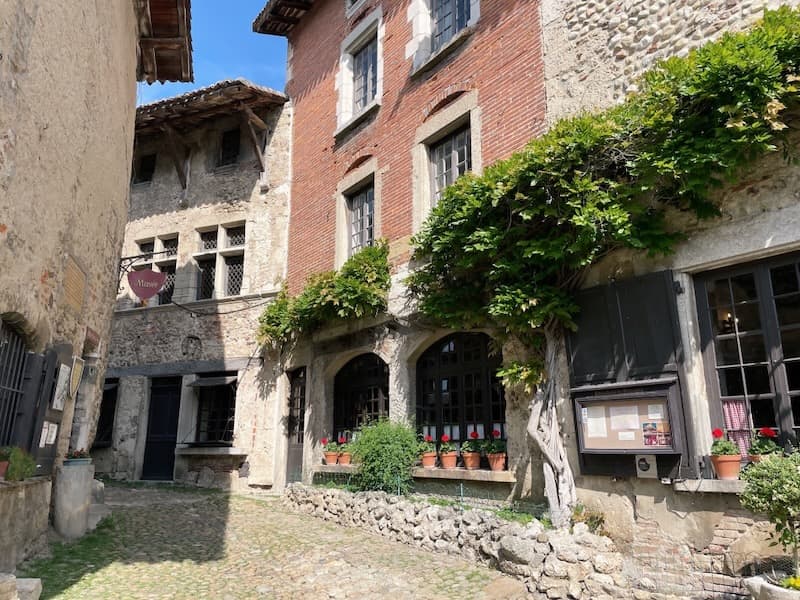
Visit the village’s artisans
The streets are dotted with artisan’s shops, but these are discreet, with none of the glaring souvenir-pushing so evident in other touristic villages.
And there are few of them, under a dozen, with such specialties as ceramics, woodwork and painting.
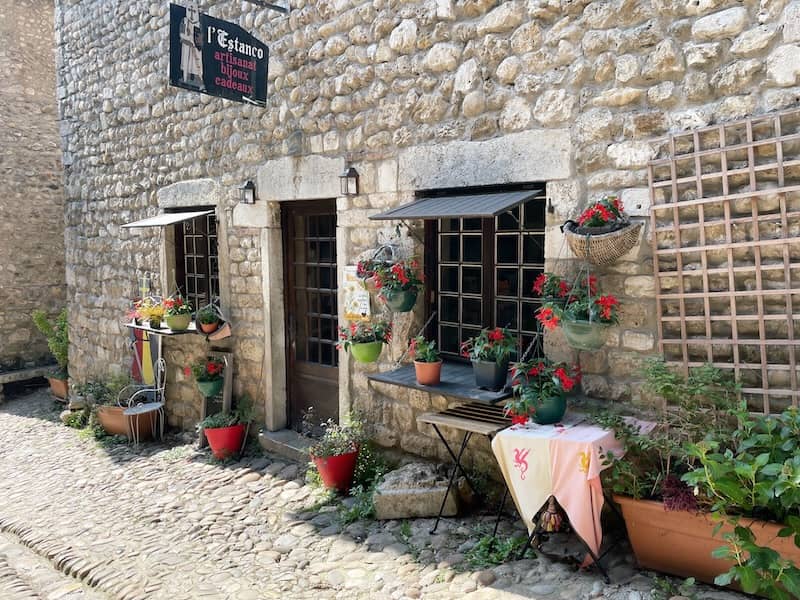
Sample a “galette de Perouges”
This is a large round sugar pie, and several bakeries sell it in the village. It won’t be hard to find – just let your nose guide you.
The galette’s trademark is registered, so you won’t find it under that name anywhere else, but if you’re curious about local cuisine, the Tarte Bressane is not dissimilar, although it has a far thicker crust.
The galette was created a century ago during the village’s renovation. After all, if one wanted to attract the riche Lyonnais for an afternoon, one had better feed them.
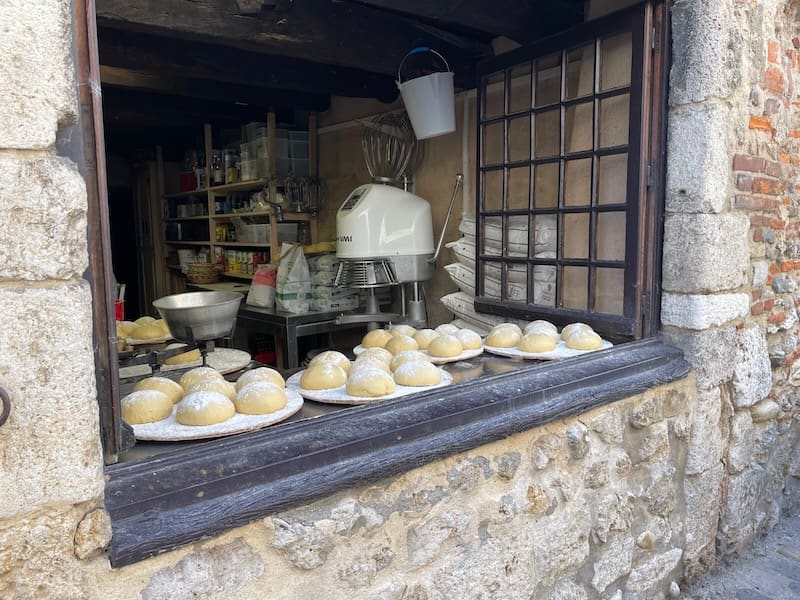
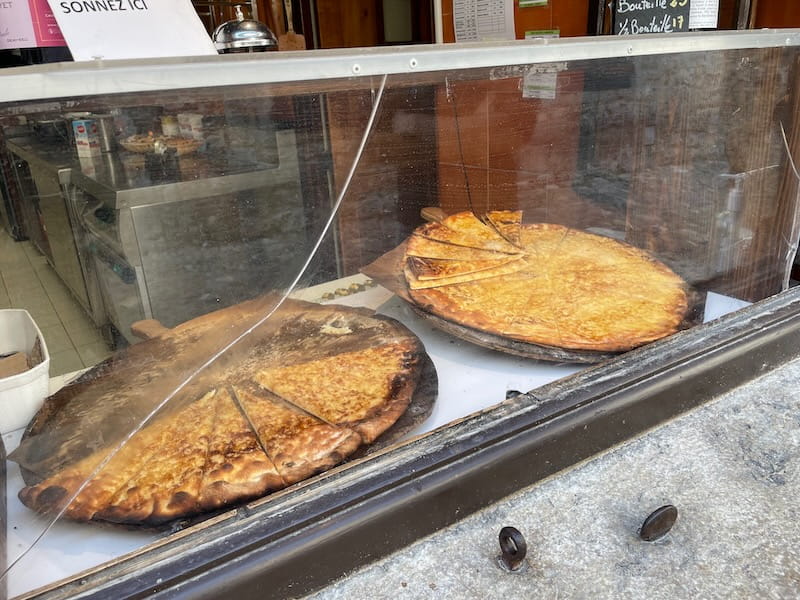
Look closely at the houses
The architecture of the village is compelling, the refurbished stone houses rebuilt according to centuries-old traditions. But on your list of what to do in Perouges should be to take a closer look.
The lower floors with large windows were the weavers’ workshops, with sunlight streaming in. Come sunset, no work was allowed. Without light, candles would have been needed, a lethal combination for interiors made of wood and filled with cloth.
Upstairs were living quarters, with the entire family sleeping in a single bed, as was common then. The downstairs windows were protected by unusual shutters. While most shutters in France are vertical, these were horizontal, folding down into a table when opened, a great place for artisans to show off their wares.
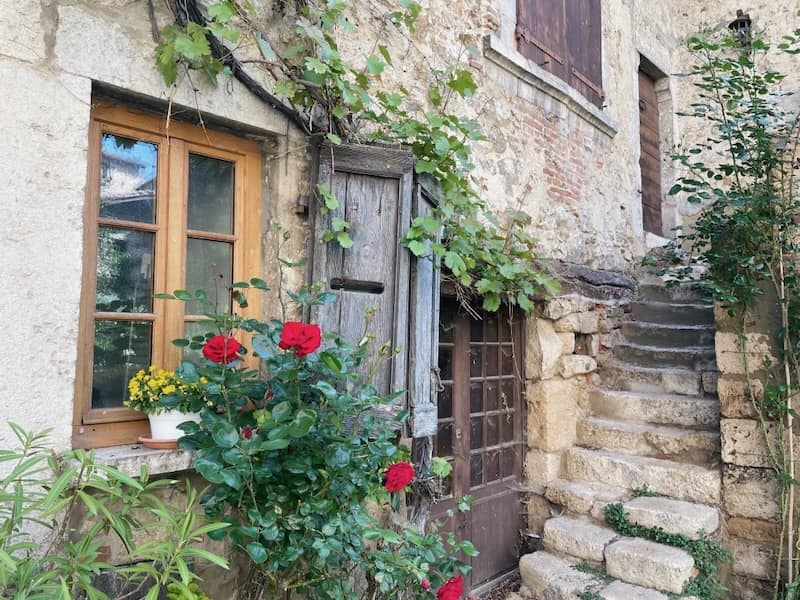
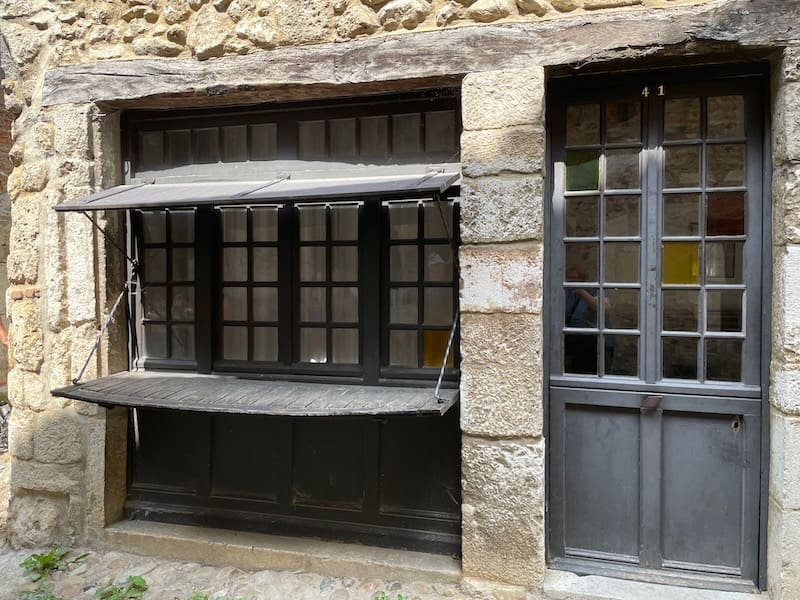
Go to church
Saint Marie Madeleine de Pérouges isn’t used for services anymore, but you can still attend weddings (and funerals) here.
Today, its rather somber decor is less than attractive but if you peer around the back of one of the columns on the left, you’ll catch a glimpse of what the colorful church might have been in medieval times. It is believed the church ceiling might have once been blue, studded with little stars…
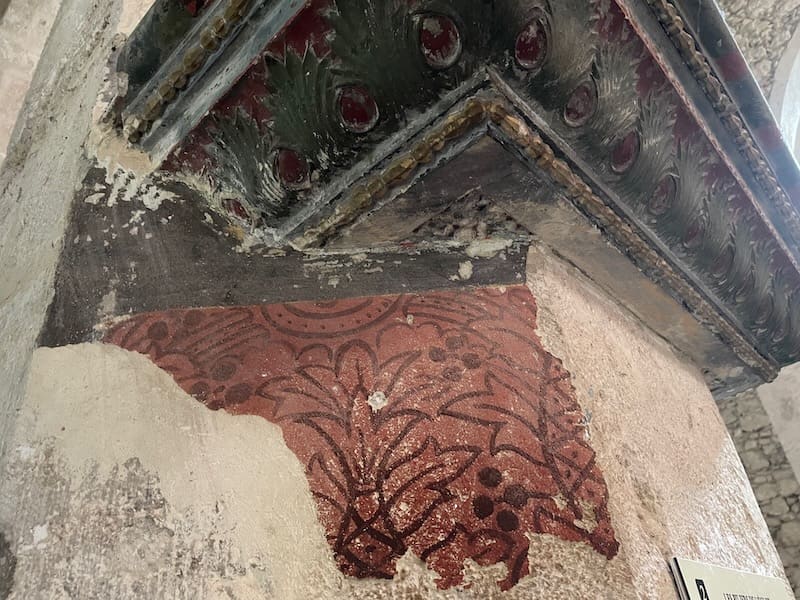
What is unusual is its architecture. Its left wall is built right into the ramparts, and its stained glass windows are tall and thin, more military in shape than religious. The belfry is barely a century old, the French Revolution having destroyed most belfries in France.
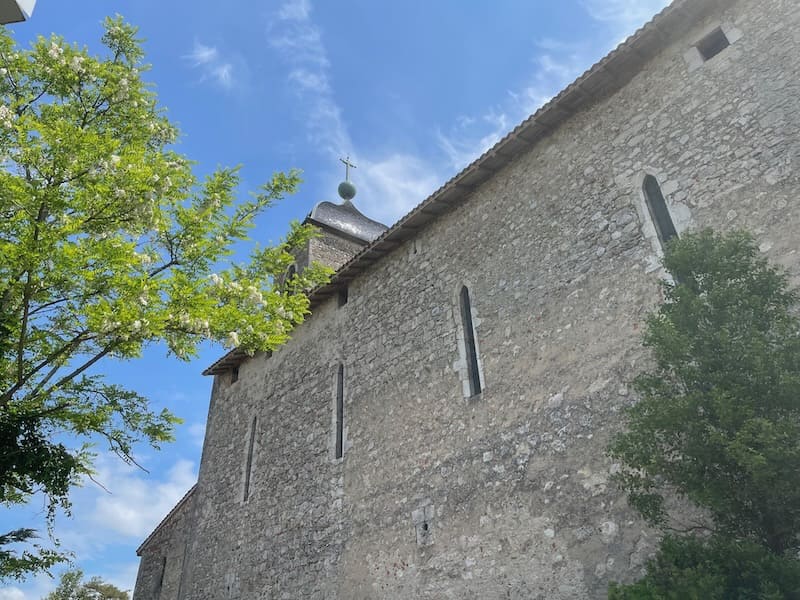
Visit the Museum of Arts and Popular Traditions
The museum is a tiny showcase, reached from the top of a creaky set of wooden stairs. Its several rooms contain an eclectic collection of items from Perouges’ past: a loom once used by local weavers, chimneys and cooking utensils, old photographs, and even a small suit of armor.
From the top floor, gaze out onto the main square for a bird’s eye view of the village’s comings and goings.
As I searched fruitlessly for the exit, I eventually found out you leave the way you came in. You’ve been warned.
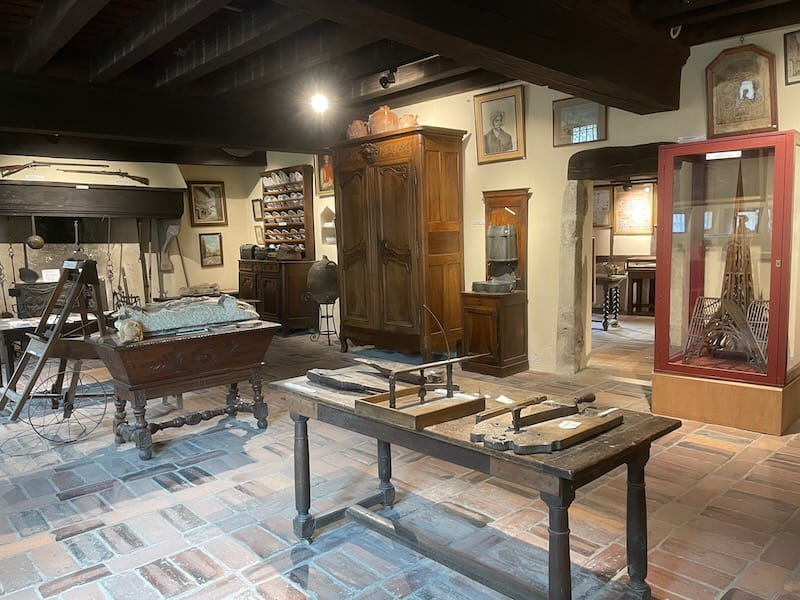
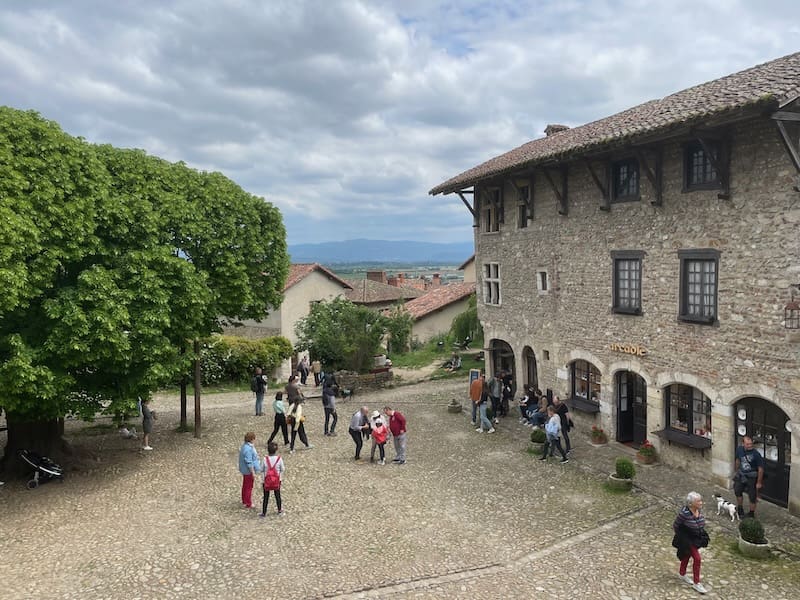
Explore the Place du Tilleul
This is where the action is!
On any given day in Perouges, things happen when groups decide to use the picturesque site as a backdrop to their activities. Today, those events are innocuous gatherings of World War II vehicles or certain breeds of dog.
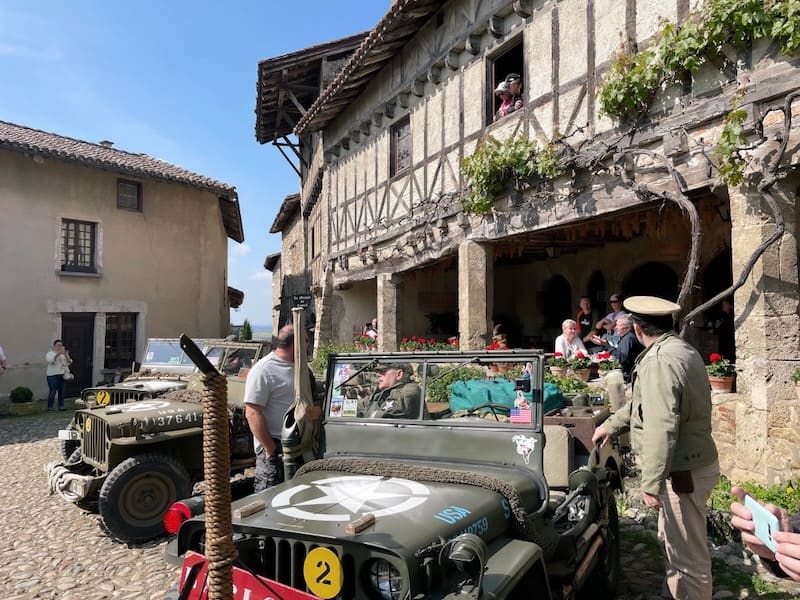
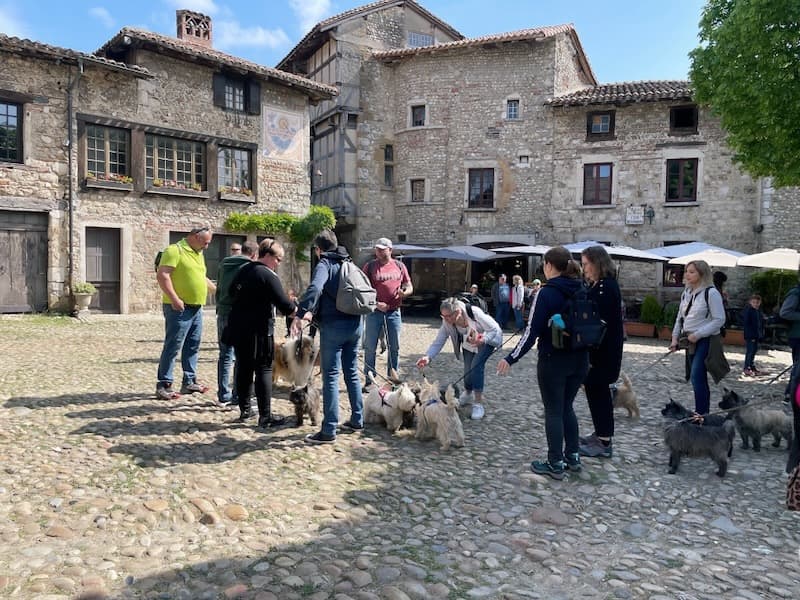
Back then, this was the site of executions, and attendance was compulsory as of the age of seven.
A VIOLENT TIME
Punishment was swift for transgressions in the Perouges of the Middle Ages.
There are documented cases of fines – for making faces at the duke or committing adultery – but these were relatively minor offences. For major crimes requiring the death penalty, an executioner was brought in from the local capital, Bourg-en-Bresse. The population would be alerted by the baker, who placed a loaf of bread upside down to announce the arrival. To this day in France, you’ll see people surreptitiously turn their bread right side up if it happens to have been wrongly positioned on their table.
Once the executioner’s job was done, he would receive a new pair of gloves and be allowed to sell the criminal’s possessions and keep the money.
Try to imagine what the square might have looked like back when it housed the local market square. The café of the Hostellerie de Perouges was a thriving exchange for local weavers, while foodstuffs were sold inside the “halles”, the covered market which burned down in 1839, and never rebuilt.
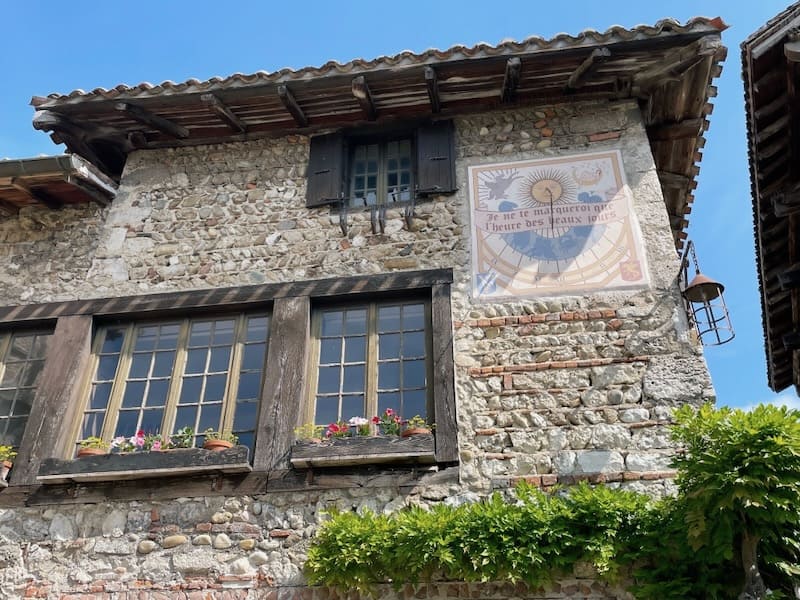
On the other side of the square from the Hostellerie, there’s a tiny statue embedded in a building: just raise your eyes and you’ll see St Georges (the French spelling for St George), one of the many saints watching over the village. In this case, there’s a dragon involved, and a slaying, and a knight in shining armor.
In fact, St Georges, the dragon slayer, had a particular significance for women: when they were ready for a partner, they would parade on the square on his day, usually 23 April.
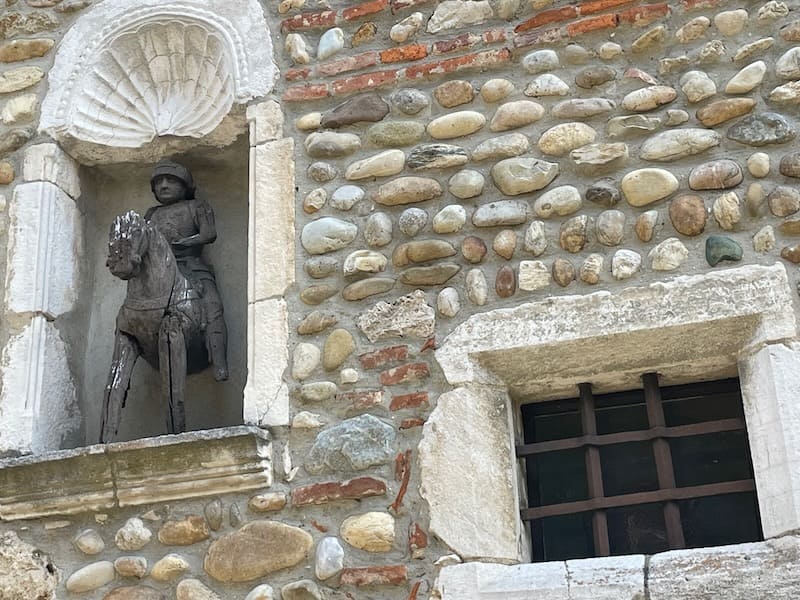
Another notable was St Martin, whose feast is celebrated on 11 November – the 4th-century saint was of Hungarian origin who eventually became bishop of Tours. It’s a holiday still celebrated in many parts of France, mostly near the German border, but not only. My own village not too far from Annecy has a major fair each year on this day.
In the middle of the square stands a lime tree, weathered by the years and propped up by large wooden beams. It is one of France’s few remaining Freedom Trees, planted to celebrate the French Revolution and its new republic. Many were felled when the Bourbon dynasty was restored, replanted when the monarchy was ousted, and so on, dependent on the whims of politics. Few of these trees are left, although more are occasionally planted. You can find their symbol on France’s €1 and €2 coins.
Take part in the medieval festival Perouges
If you’re partial to medieval re-creations and jousts, early June is the time to visit the
“cité de pérouges”, as it is known in French. For more information get in touch with the village’s tourist office.
WHAT'S IN A NAME?
The origin of the name Perouges is cloaked in history. Some documents suggest it could come from "pierres rouges", a stone used for sacrifices, hence the "rouge", or red, drenched in blood. Others believe the name comes from the Italian city of Perugia, and that the town was founded by Gauls returning from Perugia. We simply don't know.
A bit of Perouges history
The village of Perouges was first mentioned by name around 1100-1200, so its history plunges back centuries. It started life as a fortress and dungeon, surrounded by ramparts.
Throughout the Renaissance, the village flourished, an important textile center filled with weavers, mostly of hemp. It was also located strategically on the road from Lyon to Geneva, a resting place for those making the week-long journey and at the heart of dynastic battles between the houses of Dauphiné and Savoy.
Those battles would eventually end when Perouges became part of France in 1601 but the village’s fortunes wouldn’t dwindle until the 18th century, when Louis XV built a new road through Meximieux, below Perouges. Traffic began bypassing the village, inconveniently located uphill.
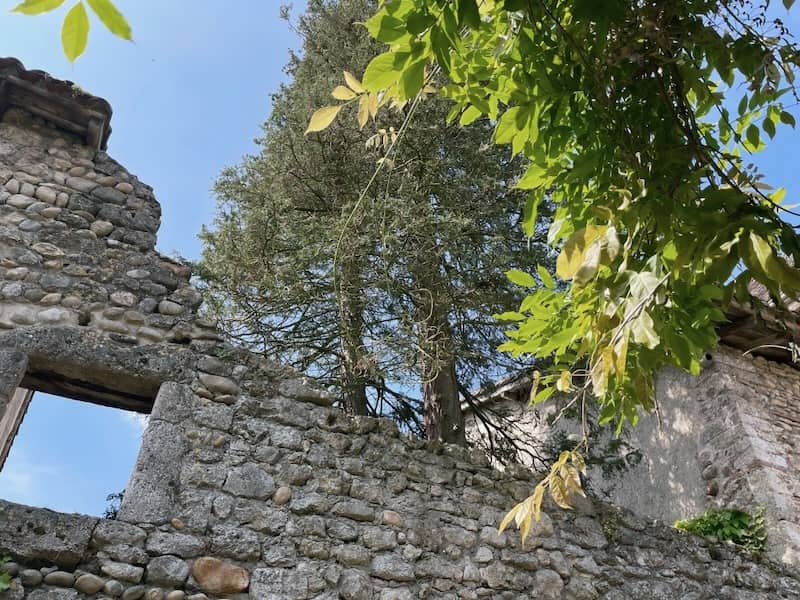
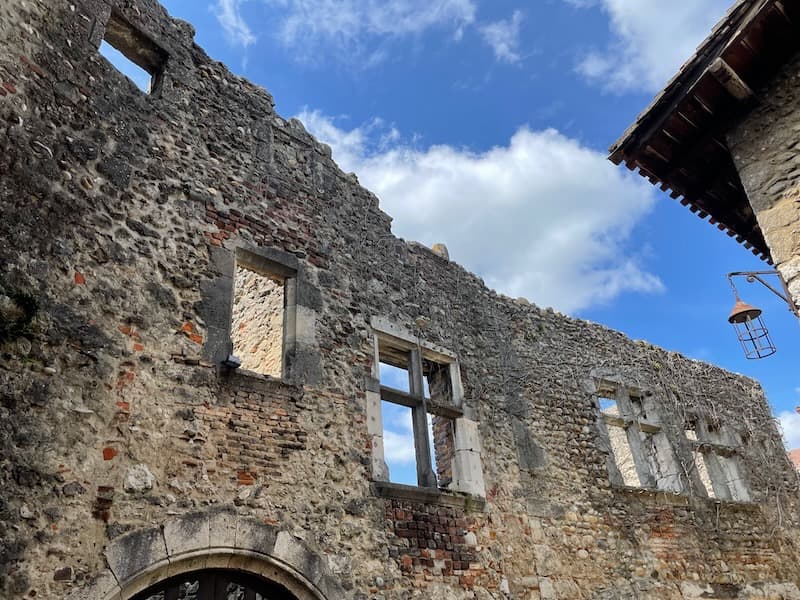
More “bad” news followed. The invention of huge jacquard looms by the silk weavers of Croix-Rousse in Lyon made business in Perouges increasingly difficult. The new looms were too large for the town’s workshops, and many weavers had to close up shop. Like the road, the new train line bypassed Perouges, stopping just down the hill in Meximieux. Reasons to visit Perouges began to decrease, and soon people were leaving.
At its height, it had a population of 1000 or so. By 1900, no more than 10 or 20 people remained. There was talk of razing the village, and that might well have happened without the foresight of those concerned citizens who banded together to save it.
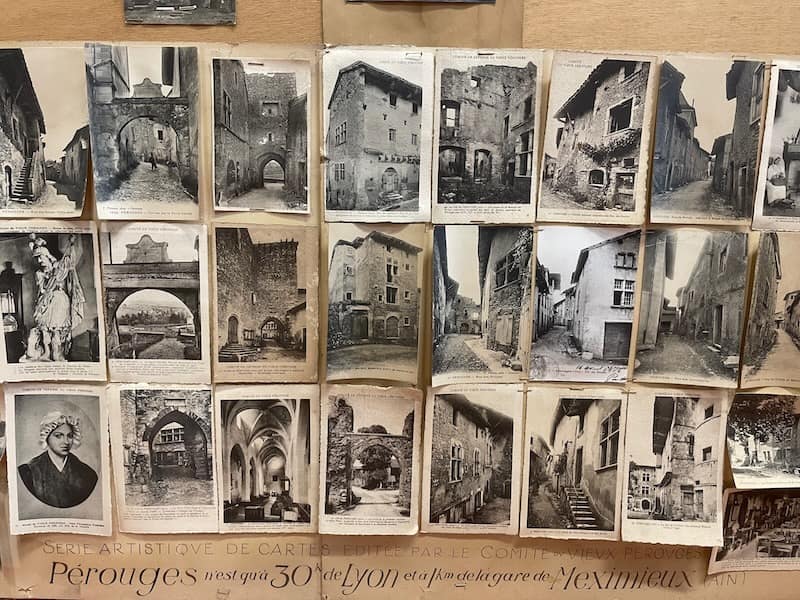
Where to eat in Perouges
In Perouges food is not hard to find. There are several restaurants, and you can’t really miss them, the village is that small. However, a word of warning: they fill up very quickly so either show up early, or drop by after 11am but before noon to reserve a table. Some have outside terraces, a pleasant experience on a warm, sunny day.
Most restaurants are similar in price (a little expensive) but each has its own specialty menu. Walk around and choose what appeals. For faster food, there’s a pizzeria across from the tourist office and another in town, several places you can buy crêpes (French pancakes), and bakeries for bread or the famed Galette de Pérouges.
Where to stay: Hotels in Perouges, France
Like many medieval villages that are full of tourists by day, by night they are nearly empty, and a delight for strollers. So if you can, spend the night!
There aren’t many Perouges hotels but the selection of Perouges accommodation is more than adequate. There are few places to stay, but there is little competition, especially outside weekends.
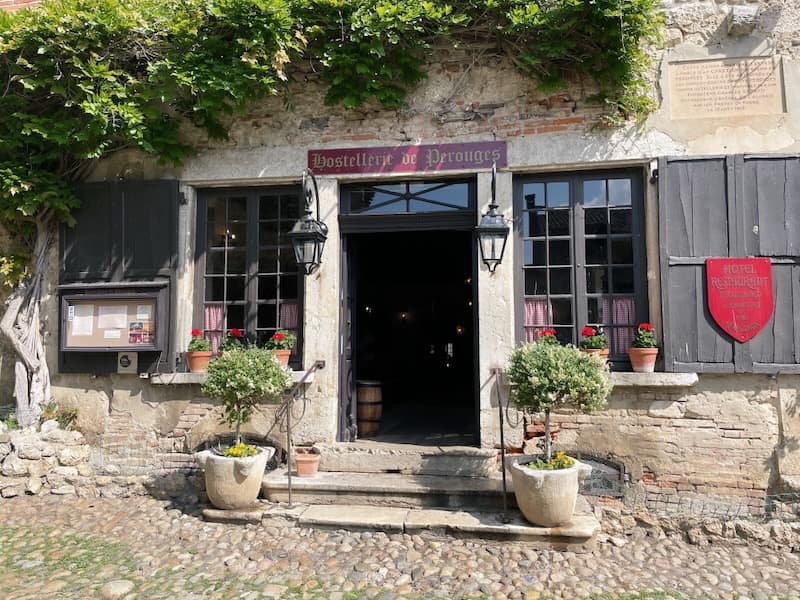
Perouges Map
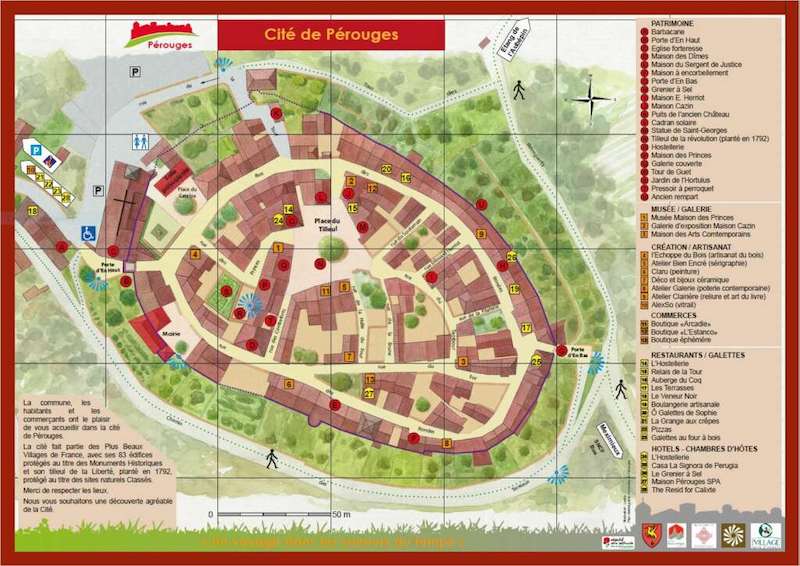
How to get to Perouges from Lyon
I say Lyon because Perouges is a perfect day trip from Lyon, which is where most visitors come from. Perouges is also not too far from Geneva, and perfectly doable on a day trip.
There are basically four ways to visit Perouges medieval village:
- You can take the Lyon-Perouges train. It runs frequently but leaves you in Meximieux, at the bottom of the hill, so you'll have to walk up.
- You can drive – Lyon to Perouges is half an hour, or an hour-and-a-half from Geneva. Perouges parking is relatively plentiful if you get there early, but you still have to walk uphill (though less than with the train). Make sure you reserve your rental car if you haven't done so yet.
- Take the Lyon-Perouges bus − it's very infrequent, takes twice as long as the train, and you’ll still have to walk up the hill.
- Take a day trip from Lyon that has already been organized, like this private guided tour or this small group tour combining Perouges and the Beaujolais – Perouges is small and you do have time to do something else on the same day.
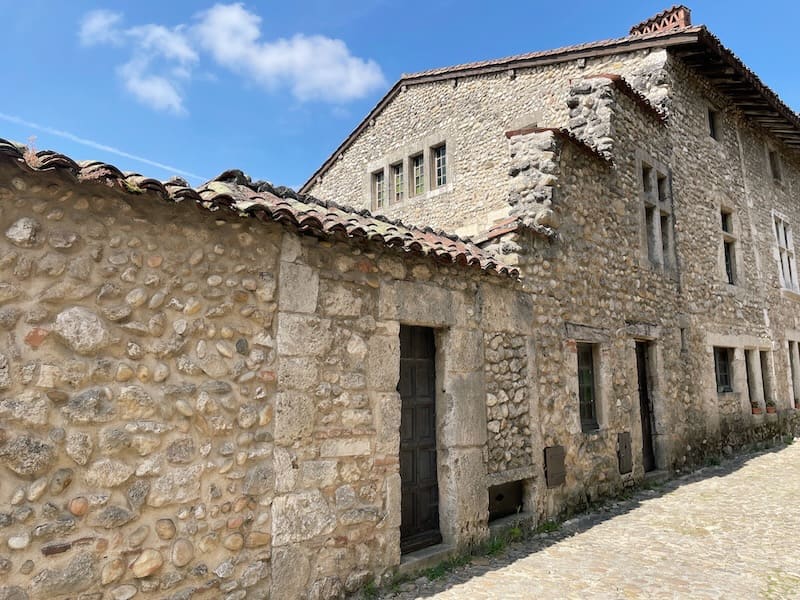
IF YOU DO NEED TO RENT A CAR IN FRANCE
Don't wait until the last minute, especially if you want one of the scarcer automatics.
🚗 Check availability at Discover Cars (it's what I use to compare prices).
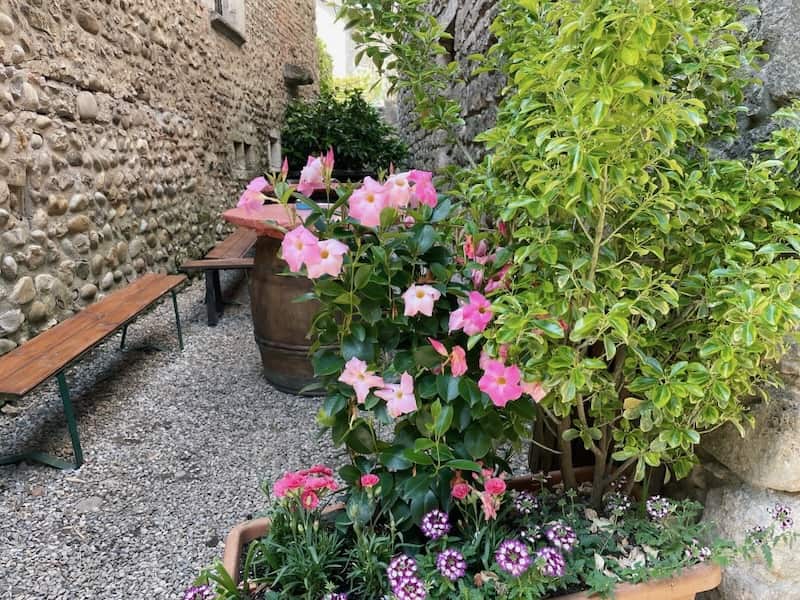
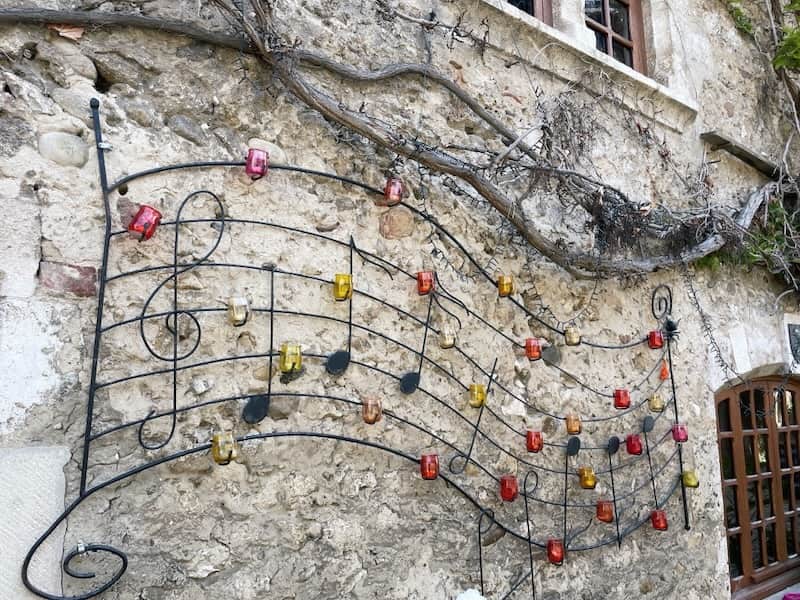
A few final thoughts about medieval Perouges
Perouges may be quaint and its streets filled with rounded cobblestones, but beware: they are extremely difficult to walk on, and near impossible in a wheelchair, with a cane or with a stroller.
There’s a reason for this. The original cobblestones were flat on top (more navigable) but were ripped up to lay cables and pipes for electricity and water. When time came to repave, it seemed easier (and not unattractive) to leave the pebbles whole. Tourists occasionally “took” a pebble home with them, undermining the streets. So the stones were cemented. As a result, the cobblestones cannot subside, and will forever remain lumpy and bumpy. Wear good shoes.
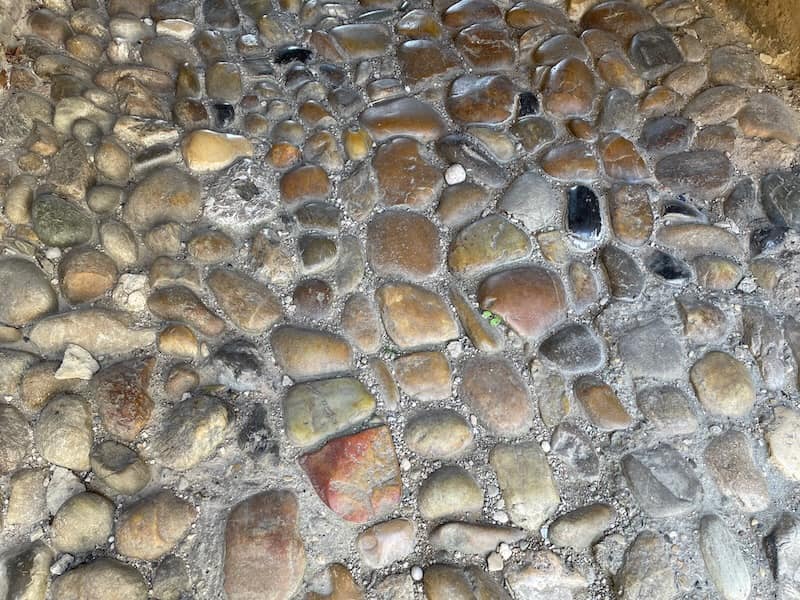
That said, the village is not completely inaccessible. By making arrangements through the tourist offices, permission can be granted to drive into the village to drop someone off for a few hours of leisure on the Place du Tilleul.
As I mentioned, there are a few automobiles in the village for residents. Visitors do glance at them sideways but unfairly, since people do have to shop and bring their groceries home, even if they live in a picturesque historical monument. I remember living in Yvoire, a beautiful medieval village on the shores of Lake Geneva, and getting nasty looks from visitors as I tried to maneuver into my tiny gated parking space. If you’re headed that way, I’ve included Yvoire in a Lake Geneva itinerary if you happen to be in Geneva.
Given the physical beauty of the village and its history, it’s not surprising that cinema crews regularly use it for filming, perhaps not quite on the scale of the film “Chocolat” in Flavigny-sur-Ozerain in Burgundy, but for period shows like the Three Musketeers. As you walk along the streets, you’ll understand the draw.
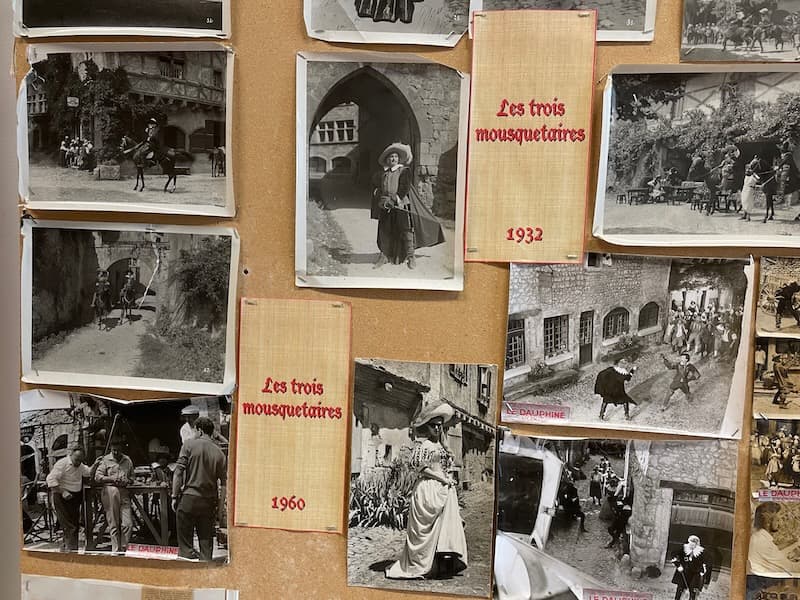
A final word: In case you’re wondering… Pérouges is spelled with an accent over the first “e”. But as is the case when writing for an English audience, accents are often removed to make it easier for Google to find the story and show it to you. So yes, there IS an accent on the first “e” in Pérouges, and yes, I’ve left it out on purpose…
Did you enjoy this article? I'd love if you shared it!
